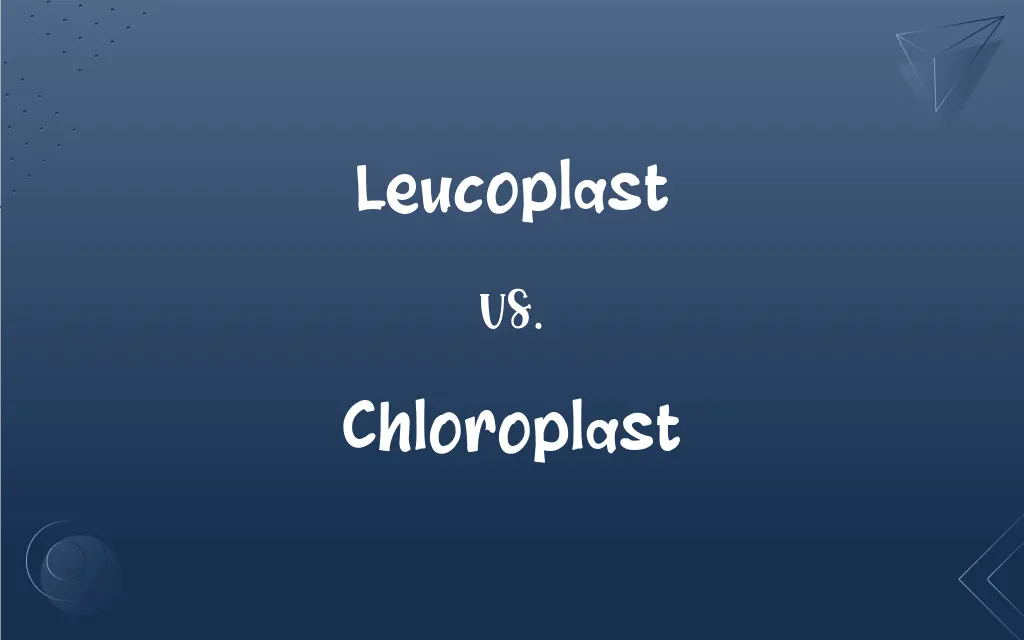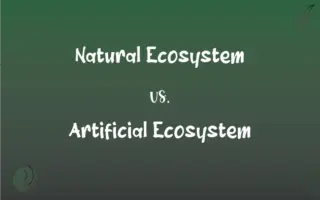Leucoplast vs. Chloroplast: What's the Difference?
Edited by Aimie Carlson || By Janet White || Published on February 9, 2024
Leucoplasts are colorless organelles storing starch, lipids, or proteins, while chloroplasts are green and conduct photosynthesis.

Key Differences
Leucoplasts are non-pigmented organelles found in plant cells, primarily involved in the storage of starch, oils, and proteins. Chloroplasts, on the other hand, are green due to the presence of chlorophyll and are crucial for photosynthesis, converting light energy into chemical energy.
In plants, leucoplasts play a key role in the synthesis and storage of various organic compounds. Chloroplasts are not just involved in photosynthesis but also in other processes like fatty acid synthesis and the immune response in plants.
Structurally, leucoplasts are generally smaller and vary in shape, adapting to their function in the cell. Chloroplasts are larger, with a complex structure including thylakoids and stroma, specialized for capturing light and performing photosynthesis.
Leucoplasts are found mostly in non-photosynthetic tissues of plants like roots, tubers, and seeds, while chloroplasts are predominantly located in the leaves and other green parts of the plant, where photosynthesis is most efficient.
Leucoplasts can differentiate into other types of plastids depending on the plant's needs, such as becoming chromoplasts during fruit ripening. Chloroplasts, however, maintain their role in photosynthesis throughout their lifecycle, being essential for the plant's energy production.
ADVERTISEMENT
Comparison Chart
Function
Storage of starch, lipids, or proteins
Photosynthesis, converting light to chemical energy
Color
Colorless
Green due to chlorophyll
Location in Plant
Non-photosynthetic tissues (roots, seeds)
Photosynthetic tissues (leaves)
Structural Complexity
Generally simpler, varies with function
Complex, with thylakoids and stroma
Role in Plant Growth and Health
Storage and synthesis of organic compounds
Essential for energy production and growth
ADVERTISEMENT
Leucoplast and Chloroplast Definitions
Leucoplast
Leucoplasts are non-pigmented organelles in plant cells for storage.
The leucoplasts in potato cells store starch.
Chloroplast
Chloroplasts convert light energy into chemical energy in plants.
In sunflowers, chloroplasts efficiently convert sunlight into energy for growth.
Leucoplast
Leucoplasts are involved in the synthesis of oils and proteins in plants.
Seeds often contain leucoplasts for the storage of oils and proteins.
Chloroplast
Chloroplasts are green organelles in plant cells responsible for photosynthesis.
Chloroplasts in the leaves capture sunlight for energy production.
Leucoplast
Leucoplasts are vital for the storage of essential nutrients in plants.
In corn seeds, leucoplasts store proteins vital for seedling development.
Chloroplast
Chloroplasts contain chlorophyll, giving plants their green color.
The green color of grass is due to the chlorophyll in chloroplasts.
Leucoplast
Leucoplasts are plastids found in roots and non-photosynthetic tissues.
In onion cells, leucoplasts are abundant due to their non-green nature.
Chloroplast
Chloroplasts are involved in processes beyond photosynthesis, like fatty acid synthesis.
Chloroplasts in olive trees contribute to the synthesis of fatty acids for oil.
Leucoplast
Leucoplasts can differentiate into other plastids based on the plant's needs.
The leucoplasts in tomato fruit may convert into chromoplasts as the fruit ripens.
Chloroplast
Chloroplasts have a complex structure with thylakoids and stroma.
The thylakoids in chloroplasts are where light-dependent reactions occur.
Leucoplast
A colorless plastid in the cytoplasm of plant cells around which starch collects.
Chloroplast
A plastid that contains chlorophyll and is found in the cells of green plants and algae.
Leucoplast
(biology) An organelle found in certain plant cells, a non-pigmented category of plastid with various biosynthetic functions.
Chloroplast
(cytology) An organelle, found in the cells of green plants and in photosynthetic algae, where photosynthesis takes place, characterized by a high concentration of chlorophyll and two membranes.
Leucoplast
One of certain very minute whitish or colorless granules occurring in the protoplasm of plants and supposed to be the nuclei around which starch granules will form.
Chloroplast
A plastid containing chlorophyll, developed only in cells exposed to the light. Chloroplasts are minute flattened granules, usually occurring in great numbers in the cytoplasm near the cell wall, and consist of a colorless ground substance saturated with chlorophyll pigments. Under light of varying intensity they exhibit phototactic movements. In animals chloroplasts occur only in certain low forms.
Chloroplast
Plastid containing chlorophyll and other pigments; in plants that carry out photosynthesis
FAQs
Where are leucoplasts commonly found?
In non-photosynthetic plant tissues like roots and seeds.
What is the primary function of chloroplasts?
To conduct photosynthesis, converting light energy into chemical energy.
Can leucoplasts convert into other organelles?
Yes, they can differentiate into other plastids like chromoplasts.
Do leucoplasts play a role in plant growth?
Yes, by storing essential nutrients and organic compounds.
What are leucoplasts?
Colorless organelles in plant cells for storing starch, lipids, or proteins.
Why are chloroplasts green?
Due to the presence of chlorophyll pigments.
Are chloroplasts found in all plant cells?
No, primarily in green, photosynthetic tissues like leaves.
Are leucoplasts visible under a light microscope?
Yes, but they are colorless and may be harder to distinguish.
How does light intensity affect chloroplasts?
It influences their efficiency in photosynthesis.
What structures are unique to chloroplasts?
Thylakoids and stroma, essential for photosynthesis.
What differentiates chloroplasts from other organelles in energy production?
Their ability to convert solar energy into usable chemical energy.
Can leucoplasts be found in fruits?
Yes, especially in non-green parts or during early development stages.
How do chloroplasts affect a plant's appearance?
They give plants a green color and are crucial for healthy growth.
Is the number of leucoplasts constant in a plant cell?
No, it varies based on the cell's developmental stage and function.
Are leucoplasts involved in energy production?
Indirectly, by storing nutrients that can be converted to energy.
What is the lifespan of chloroplasts in a plant cell?
It varies, but they can last as long as the cell is alive and healthy.
How do leucoplasts support a plant's health?
Through the synthesis and storage of vital compounds like oils and proteins.
Can chloroplasts move within plant cells?
Yes, they can move to optimize light absorption.
Do chloroplasts have a role in plant immunity?
Yes, they participate in defense mechanisms against stress and pathogens.
Do environmental factors influence leucoplast function?
Yes, factors like light and nutrient availability can impact their role.
About Author
Written by
Janet WhiteJanet White has been an esteemed writer and blogger for Difference Wiki. Holding a Master's degree in Science and Medical Journalism from the prestigious Boston University, she has consistently demonstrated her expertise and passion for her field. When she's not immersed in her work, Janet relishes her time exercising, delving into a good book, and cherishing moments with friends and family.
Edited by
Aimie CarlsonAimie Carlson, holding a master's degree in English literature, is a fervent English language enthusiast. She lends her writing talents to Difference Wiki, a prominent website that specializes in comparisons, offering readers insightful analyses that both captivate and inform.































































